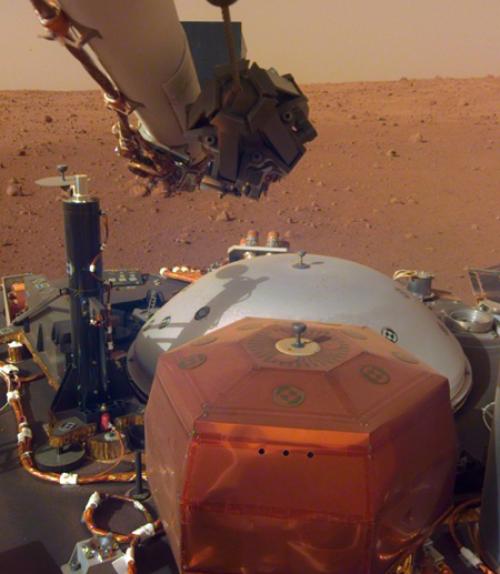The Mars InSight lander has sent back the first “sounds” ever recorded on the red planet, NASA announced Dec. 7. InSight – which touched down Nov. 26 – picked up good vibrations from the surface wind and left mission scientists in auditory awe.
“Listening to this sound from the [lander’s] pressure sensor reminds me of a windy summer afternoon, listening to the turbulent gusts come and go and whistle through your ears,” said Don Banfield, principal research scientist at Cornell and a co-investigator on InSight’s science team, at a NASA/Jet Propulsion Laboratory press conference. “In some sense, this is what it would sound like if you were sitting on the InSight lander itself on Mars.”
According to scientists, winds were blowing at 10 to 15 mph in a northwest to southeast direction at the site called Elysium Planitia. The wind vibrations were detected by two sensitive instruments: an air pressure sensor inside the lander and a seismometer, according to JPL.
The functions of the instruments are quite different. The air pressure sensor – part of the Auxiliary Payload Sensor Subsystem, an instrument for which Banfield is a co-investigator – recorded air vibrations directly, according to JPL. The seismometer recorded lander vibrations caused by the wind moving over the spacecraft’s solar panels – 7-foot spans that stick out like jumbo ears.
InSight’s pressure sensor is used to remove Mars’ atmospheric effects around the lander, much like noise-cancellation headphones, so that seismometers can eventually detect the red planet’s quakes. “We can use the pressure sensor to study the atmosphere itself,” said Banfield.
Scientists can capture the pressure signature of weather near the lander, including nearby passage of whirling dust devils, but can also capture sounds of natural sources. Said Banfield: “We would like to capture the sounds of meteors exploding into the atmosphere.”
The seismometer’s recording of the wind sounded like a bass-level, low hum. Scientists sped up the pressure sensor recording by a factor of 100 – climbing six octaves – for the human ear to hear it.
“Capturing this audio was an unplanned treat,” said Bruce Banerdt, of the California Institute of Technology/JPL, the lander’s principal investigator. “One of the things our mission is dedicated to is measuring motion on Mars, and naturally that includes motion caused by sound waves.”
This story also appeared in the Cornell Chronicle.




